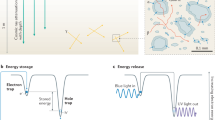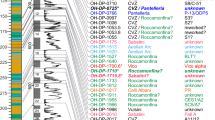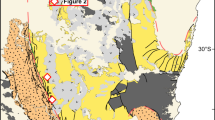Abstract
IN the last decade thermoluminescence dating has been developed for use on archaeological material, principally pottery, that was heated in antiquity1. Thermoluminescence (TL) is the light emitted by a material when heated and which results from a previous dose of radiation. In the simplest cases the light intensity is proportional to the radiation dose and can be used for determining an unknown dose; when combined with other measurements which yield the dose rate the TL can thus be used to calculate an age. In the case of pottery the event being dated is the last heating of the material to a high temperature, typically 500 °C. The use of TL to date the deposition of ocean sediments which we propose here is similar in the main principle except for the lack of the heating event. We describe here the experimental evidence which indicates that some event which has the same result does occur. We then show that exposure to sunlight could be this event, and finally show that TL dates obtained for an ocean sediment core are in agreement with dates determined independently.
This is a preview of subscription content, access via your institution
Access options
Subscribe to this journal
Receive 51 print issues and online access
$199.00 per year
only $3.90 per issue
Buy this article
- Purchase on Springer Link
- Instant access to full article PDF
Prices may be subject to local taxes which are calculated during checkout
Similar content being viewed by others
References
Aitken, M. J. Physics and Archaeology 2nd edn (Oxford University Press, London, 1974).
Zimmerman, D. W. Archaeometry 13, 29–52 (1971).
Hays, J. D., Lozano, J. A., Shackleton, N. & Irving, G., Mem. Am. geol. Soc. 145, 337–72 (1976).
Huntley, D. J. & Johnson, H. P. Can. J. Earth Sci. 13, 593–6 (1976).
Morozov, G. V. The Dating of Quaternary Ukranian Sediments by Thermoluminescence, XIIIth INQUA Congr., Paris 1969, Kiev (1968).
Shelkoplyas, V. N. in Chronology of the Glacial Age (eds Zubakov, V. A. & Kochegura, V. V.) 155–60 (Geographical Soc. USSR, Leningrad, 1971).
Faustov, S. S., Il'ichev, V. A. & Bol'shakov, V. A. Dokl. Akad. Nauk SSSR 214, 1160–2 (1974).
Yevseyev, A. V. & Il'ichev, V. A. Dokl. Akad. Nauk SSSR 214, 895–7 (1974).
Shelkoplyas, V. N., Il'ichev, V. A. & Svitoch, A. A. Dokl. Akad. Nauk SSSR 212, 935–7 (1973).
Li, J-L., Pei, J-X., Wang, Z-Z. & Lu, Y-C. Kexue Tongbao (China) 22, 498–502 (1977).
Peng, T.-H., Broecker, W. S., Kipphut, G. & Shackleton, N. in The Fate of Fossil Fuel CO2 in the Oceans (eds Anderson, N. R. & Malohoff, A.) 355–373 (Plenum, New York, 1977).
Aitken, M. J. & Bowman, S. G. E. Archaeometry 17, 132–8 (1975).
Bell, W. T. Archaeometry 18, 107–111 (1976).
Author information
Authors and Affiliations
Rights and permissions
About this article
Cite this article
WINTLE, A., HUNTLEY, D. Thermoluminescence dating of a deep-sea sediment core. Nature 279, 710–712 (1979). https://doi.org/10.1038/279710a0
Received:
Accepted:
Issue Date:
DOI: https://doi.org/10.1038/279710a0
This article is cited by
-
Optically stimulated luminescence dating using quartz
Nature Reviews Methods Primers (2021)
-
Identification of active fault topography along the Kishtwar Fault, Jammu and Kashmir, Northwest Himalaya, India
Environmental Earth Sciences (2021)
-
Ceramic chronology by luminescence dating: how and when it is possible to date ceramic artefacts
Archaeological and Anthropological Sciences (2020)
-
Illuminating the past
Nature (2015)
Comments
By submitting a comment you agree to abide by our Terms and Community Guidelines. If you find something abusive or that does not comply with our terms or guidelines please flag it as inappropriate.



